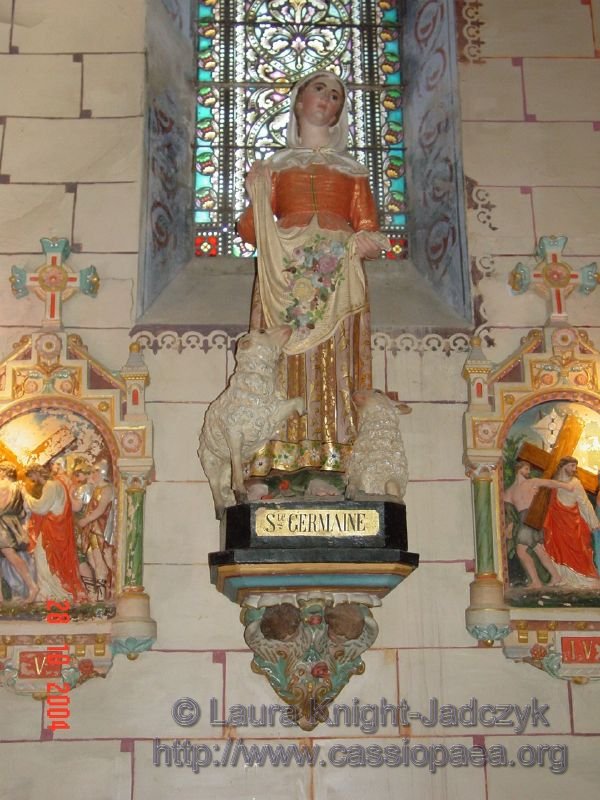The Quantum Future School Goes to Rennes-le-Chateau (25 of 68)
![[First]](bw_first.gif)
|
![[Prev]](bw_prev.gif)
|
![[Index]](bw_index.gif)
|
![[Next]](bw_next.gif)
|
![[Last]](bw_last.gif)
|

|
|
We decided to photograph all the decorations for the many readers who are curious about them after having read discussions about them in so many books and articles. Above, we see St. Germaine. St. Germaine is popular in this area of France and statues of her can be found in many churches. However, in most of the churches I have visited, such statues are generally of stone or marble, and would therefore be quite a bit more expensive. Sauniere's statues are a standard set supplied by the Giscard studio - identical but unpainted ones can be seen in the church in nearby Couiza. Is there any particular mystery to the presence of St. Germaine? Probably not. St. Germaine is also known as Germana Cousin; Germaine of Pibrac; Germana. St. Germaine was the daughter of Laurent Cousin, a farm worker, and Marie Laroche. Her mother died while Germaine was an infant. A sickly child, she suffered from scrofula, and her right hand was deformed. Ignored by her father and abused by her step-family, she was often forced to sleep in the stable or in a cupboard under the stairs, was fed on scraps, beaten or scalded with hot water for misdeeds, real or imagined. Once in winter her stepmother, Hortense, accused her of stealing bread, and threatened to beat her with a stick. Germaine opened her apron, and summer flowers tumbled out. Neighbors and her parents were awed and began to treat her as a holy person. In 1601 she was found dead on her straw pallet under the stairs, and she was buried in the Church of Pibrac opposite the pulpit. When accidentally exhumed in 1644 during a renovation, her body was found incorrupt. In 1793 the casket was desecrated by an anti-Catholic tinsmith named Toulza, who with three accomplices took out the remains and buried them in the sacristy, throwing quick-lime and water on them. After the French Revolution, her body was found to be still intact save where the quick-lime had done its work. Documents attest to more than 400 miracles or extraordinary graces through the intervention of Saint Germaine. They include cures of every kind (of blindness, both congenital and resulting from disease, of hip and spinal disease), and the multiplication of food for the distressed community of the Good Shepherd at Bourges in 1845. |
![[First]](bw_first.gif)
|
![[Prev]](bw_prev.gif)
|
![[Index]](bw_index.gif)
|
![[Next]](bw_next.gif)
|
![[Last]](bw_last.gif)
|